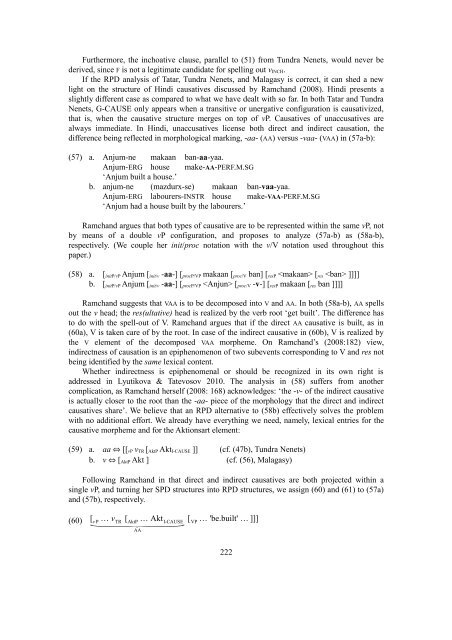Empirical Issues in Syntax and Semantics 9 (EISS 9 ... - CSSP - CNRS
Empirical Issues in Syntax and Semantics 9 (EISS 9 ... - CSSP - CNRS
Empirical Issues in Syntax and Semantics 9 (EISS 9 ... - CSSP - CNRS
Create successful ePaper yourself
Turn your PDF publications into a flip-book with our unique Google optimized e-Paper software.
Furthermore, the <strong>in</strong>choative clause, parallel to (51) from Tundra Nenets, would never be<br />
derived, s<strong>in</strong>ce F is not a legitimate c<strong>and</strong>idate for spell<strong>in</strong>g out v INCH .<br />
If the RPD analysis of Tatar, Tundra Nenets, <strong>and</strong> Malagasy is correct, it can shed a new<br />
light on the structure of H<strong>in</strong>di causatives discussed by Ramch<strong>and</strong> (2008). H<strong>in</strong>di presents a<br />
slightly different case as compared to what we have dealt with so far. In both Tatar <strong>and</strong> Tundra<br />
Nenets, G-CAUSE only appears when a transitive or unergative configuration is causativized,<br />
that is, when the causative structure merges on top of vP. Causatives of unaccusatives are<br />
always immediate. In H<strong>in</strong>di, unaccusatives license both direct <strong>and</strong> <strong>in</strong>direct causation, the<br />
difference be<strong>in</strong>g reflected <strong>in</strong> morphological mark<strong>in</strong>g, -aa- (AA) versus -vaa- (VAA) <strong>in</strong> (57a-b):<br />
(57) a. Anjum-ne makaan ban-aa-yaa.<br />
Anjum-ERG house make-AA-PERF.M.SG<br />
‘Anjum built a house.’<br />
b. anjum-ne (mazdurх-se) makaan ban-vaa-yaa.<br />
Anjum-ERG labourers-INSTR house make-VAA-PERF.M.SG<br />
‘Anjum had a house built by the labourers.’<br />
Ramch<strong>and</strong> argues that both types of causative are to be represented with<strong>in</strong> the same vP, not<br />
by means of a double vP configuration, <strong>and</strong> proposes to analyze (57a-b) as (58a-b),<br />
respectively. (We couple her <strong>in</strong>it/proc notation with the v/V notation used throughout this<br />
paper.)<br />
(58) a. [ <strong>in</strong>itP/vP Anjum [ <strong>in</strong>it/v -aa-] [ procP/VP makaan [ proc/V ban] [ resP [ res ]]]]<br />
b. [ <strong>in</strong>itP/vP Anjum [ <strong>in</strong>it/v -aa-] [ procP/VP [ proc/V -v-] [ resP makaan [ res ban ]]]]<br />
Ramch<strong>and</strong> suggests that VAA is to be decomposed <strong>in</strong>to V <strong>and</strong> AA. In both (58a-b), AA spells<br />
out the v head; the res(ultative) head is realized by the verb root ‘get built’. The difference has<br />
to do with the spell-out of V. Ramch<strong>and</strong> argues that if the direct AA causative is built, as <strong>in</strong><br />
(60a), V is taken care of by the root. In case of the <strong>in</strong>direct causative <strong>in</strong> (60b), V is realized by<br />
the V element of the decomposed VAA morpheme. On Ramch<strong>and</strong>’s (2008:182) view,<br />
<strong>in</strong>directness of causation is an epiphenomenon of two subevents correspond<strong>in</strong>g to V <strong>and</strong> res not<br />
be<strong>in</strong>g identified by the same lexical content.<br />
Whether <strong>in</strong>directness is epiphenomenal or should be recognized <strong>in</strong> its own right is<br />
addressed <strong>in</strong> Lyutikova & Tatevosov 2010. The analysis <strong>in</strong> (58) suffers from another<br />
complication, as Ramch<strong>and</strong> herself (2008: 168) acknowledges: ‘the -v- of the <strong>in</strong>direct causative<br />
is actually closer to the root than the -aa- piece of the morphology that the direct <strong>and</strong> <strong>in</strong>direct<br />
causatives share’. We believe that an RPD alternative to (58b) effectively solves the problem<br />
with no additional effort. We already have everyth<strong>in</strong>g we need, namely, lexical entries for the<br />
causative morpheme <strong>and</strong> for the Aktionsart element:<br />
(59) a. aa ⇔ [[ vP v TR [ AktP Akt I-CAUSE ]] (cf. (47b), Tundra Nenets)<br />
b. v ⇔ [ AktP Akt ] (cf. (56), Malagasy)<br />
Follow<strong>in</strong>g Ramch<strong>and</strong> <strong>in</strong> that direct <strong>and</strong> <strong>in</strong>direct causatives are both projected with<strong>in</strong> a<br />
s<strong>in</strong>gle vP, <strong>and</strong> turn<strong>in</strong>g her SPD structures <strong>in</strong>to RPD structures, we assign (60) <strong>and</strong> (61) to (57a)<br />
<strong>and</strong> (57b), respectively.<br />
⏟<br />
AA<br />
(60) [ vP<br />
… v TR<br />
[ AktP<br />
… Akt I-CAUSE<br />
[ VP<br />
… 'be.built' … ]]]<br />
222











